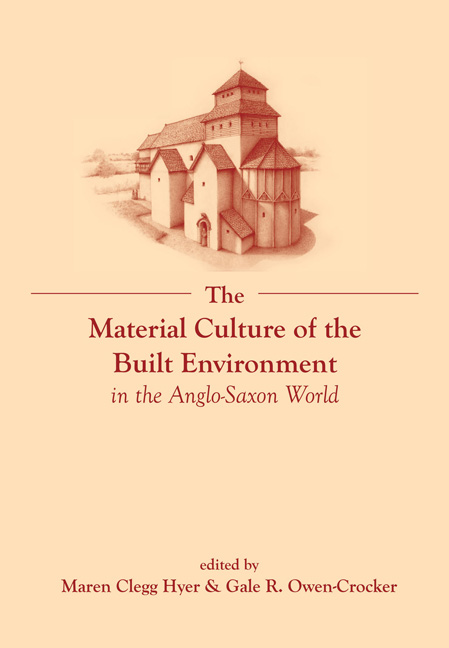Book contents
- Frontmatter
- Dedication
- Contents
- List of Figures
- List of Tables
- List of Contributors
- Introduction
- 1 Enta geweorc: The Ruin and its Contexts Reconsidered
- 2 Roads and Tracks in Anglo-Saxon England
- 3 Domestic Dwellings, Workshops and Working Buildings
- 4 Place and Power: Meetings between Kings in Early Anglo-Saxon England
- 5 The Cuckoo and the Magpie: The Building Culture of the Anglo-Saxon Church
- 6 Landmarks of Faith: Crosses and other Free-standing Stones
- 7 Landmarks of the Dead: Exploring Anglo-Saxon Mortuary Geographies
- 8 Boundaries and Walls
- 9 The Landscape of Late Saxon Burhs and the Politics of Urban Foundation
- 10 Signalling Intent: Beacons, Lookouts and Military Communications
- Notes
- Suggested Reading
- Index
4 - Place and Power: Meetings between Kings in Early Anglo-Saxon England
- Frontmatter
- Dedication
- Contents
- List of Figures
- List of Tables
- List of Contributors
- Introduction
- 1 Enta geweorc: The Ruin and its Contexts Reconsidered
- 2 Roads and Tracks in Anglo-Saxon England
- 3 Domestic Dwellings, Workshops and Working Buildings
- 4 Place and Power: Meetings between Kings in Early Anglo-Saxon England
- 5 The Cuckoo and the Magpie: The Building Culture of the Anglo-Saxon Church
- 6 Landmarks of Faith: Crosses and other Free-standing Stones
- 7 Landmarks of the Dead: Exploring Anglo-Saxon Mortuary Geographies
- 8 Boundaries and Walls
- 9 The Landscape of Late Saxon Burhs and the Politics of Urban Foundation
- 10 Signalling Intent: Beacons, Lookouts and Military Communications
- Notes
- Suggested Reading
- Index
Summary
Nam Inhrypis basilicam polito lapide a fundamentis in terra usque ad summum aedificatam, variis columnis et porticibus suffultam, in altum erexit et consummavit. Iam postea, perfecta domu, ad diem dicationis eius, invitatis regibus christianissimis et piissimis Ecgfritho et Aelwino, duobus fratribus, cum abbatibus praefectisque et sub-regulis, totiusque dignitatis personae
For in Ripon he built and completed from the foundations in the earth up to the roof, a church of dressed stone, supported by various columns and side aisles. Afterwards, when the building had been finished, he invited to the day of its dedication the two most Christian kings and brothers, Ecgfrith and Aelfwini, together with the abbots, the reeves and the sub-kings; dignitaries of every kind
Introduction
This chapter considers face-to-face meetings between kings in Anglo-Saxon England in the seventh and eighth centuries. It examines the kinds of places where these meetings took place (the built environments of kingly meetings), some of the reasons for kings coming together and some of the outcomes of these royal meetings.
Britain in the seventh and eighth centuries was a land of many small kingdoms. Thus there was inherently more likelihood here of kings interacting directly than there was in contemporary continental Europe, with its large polities, and kings did indeed regularly have personal, face-to-face meetings in early Anglo-Saxon England. Though not uncommon, however, such royal meetings were highly charged events, redolent with the rituals, ceremonial, symbolism and hierarchies of status and power. They required suitable venues – places that could provide accommodation suitable for kings, and that were also large enough, and well-provisioned enough, to accommodate and feed the royal retinues, which would typically include family, councillors, priests, household warriors and servants, together with their baggage and horses.
The number of Anglo-Saxon kingdoms declined significantly during the seventh and eighth centuries. In the first half of the seventh century a minimalist interpretation might argue for ten or a dozen, while a maximalist vision might see more than thirty. By the late eighth century there were five, and the independence of one of these, Kent, was soon to end. It will be suggested that some of the kingly meetings discussed here reinforced a system of multiple, interlinked and hierarchically organised kingdoms.
- Type
- Chapter
- Information
- Publisher: Liverpool University PressPrint publication year: 2015



